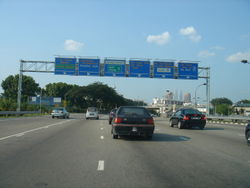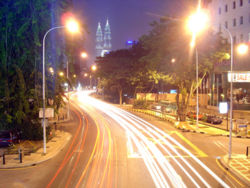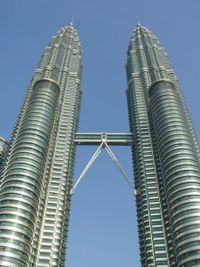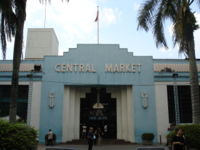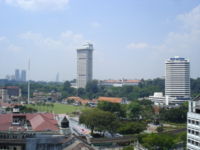Kuala Lumpur
2007 Schools Wikipedia Selection. Related subjects: Geography of Asia
| Kuala Lumpur | |||
|
|||
| Nickname: "KL" | |||
| Motto: 'Maju dan makmur ( Malay: Peace and progress)' | |||
| Location in Malaysia | |||
| Coordinates: | |||
|---|---|---|---|
| Country | Malaysia | ||
| State | Federal Territory | ||
| Establishment | 1857 | ||
| Granted city status | 1974 | ||
| Mayor | Ruslin Hasan | ||
| Area | |||
| - City | 243.65 km² (95.18 sq mi) | ||
| Elevation | 21.95 m (72 ft) | ||
| Population | |||
| - City (2004) | 1,479,388 | ||
| - Density | 6074/km² (15,543/sq mi) | ||
| - Metro | 6,527,057 (2006) | ||
| Time zone | MST ( UTC+8) | ||
| - Summer ( DST) | MST ( UTC+8) | ||
|
|||
| Website: http://www.dbkl.gov.my/ | |||
Kuala Lumpur is the capital and the largest city of Malaysia. Kuala Lumpur is one of the three Malaysian Federal Territories. It is an enclave within the state of Selangor, on the central west coast of Peninsular Malaysia. Within Malaysia, the city is commonly referred to as KL.
The city previously hosted the Malaysian judiciary and executive arms. With the completion of Putrajaya in the late 1990s, both arms have since migrated to Putrajaya, though sections of the judicial branch still remain in Kuala Lumpur. The Malaysian Parliament still operates in the city, and thus the city remains the legislative capital of the country.
History
Kuala Lumpur had its origins in the 1850s, when the Malay Chief of Klang sent Chinese upriver from China to open new and larger tin mines where Kuala Lumpur previously is rich in tins. They landed at the confluence of Sungai Gombak (previously Sg. Lumpur, which means Muddy River) and Sungai Klang (Klang River) and established mines at Ampang. Later, tin mines were opened at Pudu and Batu.
This trading post was a wild frontier town plagued by floods, fires, disease and the Selangor Civil War (1870-73). During this time, Kapitan Cina Yap Ah Loy emerged as a leader, responsible for the survival and growth of the town. In 1880 in view of its strategic location, the Selangor state capital was moved from Klang to Kuala Lumpur. Nothing of this earlier period remains as all structures were of wood and atap (thatch) which were destroyed in the fire and subsequent flood of 1881.
Thereafter, Frank Swettenham, the British Resident of Selangor who was instrumental in the development of the town, required that buildings be constructed of brick and tile. The advent of the railway increased accessibility. The development of buildings intensified in the 1890s so that it warranted the establishment of a Sanitary Board. In 1896, Kuala Lumpur was chosen as the capital of the newly formed Federated Malay States.
The multiracial community of this period settled in various sections of town. Market Square, east of Sungai Klang, became the commercial centre for the whole town. The Chinese congregated around this Square and south into Chinatown. To the north, across Java Street (now Jalan Tun Perak). were the Malays. Nearby, a number of Indian Chettiars (money-lenders), and in later years Indian Muslim traders, set up business. West of the river, the Padang (now Merdeka Square) was the focal point of the British administration.
Kuala Lumpur continued to grow despite two World Wars, the rubber and tin commodity crash and the State of Emergency (1948-60) during which Malaya was preoccupied with the Communist insurgency. In 1957, the Federation of Malaya gained its independence from British rule. Kuala Lumpur remained the capital through the formation of Malaysia, achieving city status in 1972, and was established as the Federal Territory in 1974.
Geography
Kuala Lumpur is located at the confluence of Klang and Gombak River. Mostly surrounded by forests and hills, it is the only city in the world to have a million-year-old primary forest within the heart of the city. There is no sea surrounding Kuala Lumpur.
Climate
Kuala Lumpur enjoys year round equatorial climate which is warm and sunny, along with plentiful rainfall, especially during the southwest monsoon from April to September. Due to the close proximity of Kuala Lumpur to the Sumatra Island, dust particles are carried by wind from frequent forest fires, creating a phenomenon known as the haze. This usually lasts for 1 to 2 weeks.
| Month | Jan | Feb | Mar | Apr | May | Jun | Jul | Aug | Sep | Oct | Nov | Dec |
|---|---|---|---|---|---|---|---|---|---|---|---|---|
| Average min (°C) | 22.1 | 22.3 | 22.8 | 23.4 | 23.1 | 22.1 | 22.7 | 22.7 | 22.7 | 22.9 | 22.9 | 22.5 |
| Average max (°C) | 31.9 | 32.8 | 33.1 | 33.0 | 32.8 | 32.5 | 32.1 | 32.2 | 31.9 | 31.8 | 31.4 | 31.5 |
| Lowest recorded (°C) | 19 | 21 | 20 | 21 | 22 | 20 | 19 | 19 | 20 | 21 | 21 | 19 |
| Highest recorded (°C) | 35 | 36 | 37 | 36 | 35 | 36 | 36 | 36 | 35 | 36 | 35 | 34 |
| Average rainfall (millimeters) | 163 | 145 | 218 | 285 | 184 | 127 | 129 | 146 | 192 | 272 | 275 | 230 |
| Ave no of days with 1 mm | 10 | 11 | 14 | 16 | 13 | 9 | 10 | 11 | 13 | 17 | 18 | 15 |
National Enviroment Agency,Singapore
Mayors of Kuala Lumpur
Since Kuala Lumpur became a Federal Territory of Malaysia on February 1, 1972, the city has been led by seven mayors. They are:
- Tan Sri Dato' Lokman Yusof (1972)
- Tan Sri Yaakob Latiff (1973 - 1983)
- Tan Sri Dato' Elyas Omar (1983 - 1992)
- Dato' Dr. Mazlan Ahmad (1992 - 1995)
- Tan Sri Dato’ Kamaruzzaman Shariff (1995 - 2001)
- Datuk Mohmad Shaid Mohd Taufek (2001 - 2004)
- Datuk Ruslin Hasan (2004 - current)
As local government elections in Malaysia have been suspended since 1970, mayors are appointed by the Federal Territories Minister.
Arts
Kuala Lumpur is a hub for cultural activities and events. Among the centres is the National Museum which is situated along the Mahameru Highway. It offers various types of collection such as artefacts and paintings collected throughout the country.
Another arts venue is the Kuala Lumpur Philharmonic Hall. It is headquartered to the Malaysian Philharmonic Orchestra (MPO), comprising an cast of international musicians and features regular concerts, chamber concerts and traditional cultural performances.
The Petronas Art Gallery, a centre for fine art is situated in Kuala Lumpur City Centre (KLCC). The Kuala Lumpur Performing Arts Centre (KLPac) in Sentul West is also a noted centre for the performing arts, notably theatre and music (it can also host film screening). It has housed many local productions and has been a supporter of local and regional independent performance artists. Amongst the highlights of the year so far was the KL Sing Song 2006 music fest which featured Malaysian singer-songwriters of various cultural backgrounds, from both West and East Malaysia, through two days of performances and workshops.
Kuala Lumpur holds an annual festival called Malaysia International Gourmet Festival. It is primarily held in the city centre. Another event in Kuala Lumpur is Kuala Lumpur Fashion week, which includes international brands as well as local designers.
Transportation
Land
Kuala Lumpur has a road network leading to the rest of Peninsular Malaysia. Motorists may have a choice of paying cash, using stored value card Touch 'n Go or SmartTag to pay at the toll booths while using the highways/expressways. A near-complete project, SMART Tunnel will allow motorists to enter the city, avoiding congestion by using an underground tunnel.
However, despite all this, Kuala Lumpur often has traffic problems, and peak hour traffic is generally from 7:30am to 8:45am, and from 5:45pm to 8:30pm.
Air
Kuala Lumpur is directly connected to the Kuala Lumpur International Airport (KLIA) in Sepang via the KLIA Ekspres high-speed train service which takes only 28 minutes, while travelling by car via highway will take about an hour. The former international airport, Sultan Abdul Aziz Shah Airport in Subang is now used for chartered flights.
Malaysia Airlines and all major international airlines to Malaysia land at KLIA. AirAsia makes use of the newly built Low Cost Carrier Terminal (LCC-T) in Sepang. LCC-T is accessible to/from KL through a bus service from KL Sentral (transport hub).
Public transportation
Public transport in Kuala Lumpur and the rest of the Klang Valley covers a variety of transport modes such as bus, rail and taxi. Unlike most other major Asian cities, utilisation rates are low as only 16 percent of the population uses public transportation.
In addition, there is the metro system consisting of 3 separate lines, which meet in the city and extend to the Western Suburbs of the state of Selangor. The metro system consists of a Monorail, an Elevated Metro, and an Automated Metro with underground stations in the city centre. Food, pets, drinks are strictly prohibited among trains and heavy penalties are charged upon violation. Commuter trains also exists to link commuters to the city. The main hub is KL Sentral facilitating as an interchange station for the main lines.
Places of interest
There are popular tourist locations in and around Kuala Lumpur.
Within Kuala Lumpur
- The Golden Triangle, the commercial hub of the city, contains the Petronas Twin Towers and has a distinctive nightlife.
- The Petronas Twin Towers were the world's tallest twin towers and second and third-tallest singular towers, standing adjacent to one of the busiest shopping malls in Malaysia, Suria KLCC.
- The Menara Kuala Lumpur, currently the world's fifth tallest telecommunication tower, is located on the Bukit Nanas hill beside Convent Bukit Nanas.
- Putra World Trade Centre (PWTC) is the first convention and exhibition centre in Malaysia.
- Kuala Lumpur Convention Centre (also known as KLCC) is another convention and exhibition centre in Kuala Lumpur. It is situated in the Petronas Twin Towers and Suria KLCC area. Aquaria KLCC is also situated in this building.
- Dayabumi a major landmark located near Masjid Negara. It is an office building.
- Kuala Lumpur General Post Office is located next to Dayabumi.
- Lake Gardens, a 920,000 square metre manicured garden near the Malaysian Parliament building, was once home to a British colonial official. They include a Butterfly Park, Deer Park, Orchid Garden, Hibiscus Garden and South-East Asia's largest Bird Park. ( Bird park pics)
- Stadium Merdeka (Independence Stadium), was initially erected for the country's declaration of independence on August 31, 1957.
- Dataran Merdeka (Independence Square/Merdeka Square), was the site of the lowering of the Union Jack flag and hoisting of the Malayan flag on the start of August 31, 1957. The square itself has historic association with its surroundings, namely the Royal Selangor Club, National History Museum and the architecturally Victorian-Moorish or 'Raj' influenced Sultan Abdul Samad Building.
- Kuala Lumpur Railway Station, a Victorian-Moorish railway station, was completed in 1911, and superseded by KL Sentral in 2001; it currently serves commuter trains only.
- The Muzium Negara (National Museum) incorporates neo traditionalism into its architectural design.
- The Masjid Negara (National Mosque), a post modernist mosque, was completed in 1965 and Makam Pahlawan (Heroes Mausoleum) the mausoleum of Malaysian leaders.
- The Parliament House, a Malaysian federal government legislative building, was completed on 1963.
- The Tugu Negara (National Monument) commemorates those who died in Malaysia's struggles for freedom (principally against the Japanese occupation and during the Malayan Emergency of 1946-60).
- The Istana Negara, official residence of Their Majesties the King and Queen.
- The National Science Centre, located in Bukit Damansara.
- The Federal Territory Mosque located along Jalan Duta.
- Bukit Nanas Forest Reserve, a gazetted small tropical forest located on the centre of Kuala Lumpur City.
- Many of the largest celebrations of Chinese cultural festivals are held at the Thean Hou Temple on Robson Hill.
- The Chinese Night Market area ( Chinatown), Petaling Street, has recently undergone a makeover; the most notable feature is the new covered walkway.
- Mid Valley Megamall, one of the largest shopping malls(situated in Bangsar).
- Bukit Bintang, the ultimate shopping and entertainment experience in the Golden Triangle.
- Berjaya Times Square, the largest shopping mall in Kuala Lumpur.
- The Mall is the main shopping complex near Putra World Trade Centre.
- Kuala Lumpur's Central Market, which was once the city's wet market, offers an assortment of arts and craft merchandise, varying from antiques and paintings to souvenirs and clothing. It is also known as Pasar Seni in Malay.
- Trendy nightclubs, bars and lounges, such as Hard Rock Cafe, Zouk and Thai Club are located within and around Jalan P.Ramlee, Jalan Sultan Ismail and Jalan Ampang.
- For those seeking to tantalize their tastebuds or just want to have a great night out, Heritage Row in Jalan Doraisamy provides the perfect balance of chic restaurants, nightclubs and bars.
- Brickfields, Jalan Masjid India and Lebuh Ampang are 'Little India's spread around KL showing Indian presence in KL. You can come here for great Indian food and shopping.
- Hindu temples such as Sri Mahamariamman temple near Central Market and Sri Kandaswamy Kovil in Brickfields
Around the Kuala Lumpur area
- Batu Caves is located 13 kilometres north of Kuala Lumpur. It is a sacred place for Hindus in Malaysia and is home to a Hindu temple dedicated to Lord Murugan. Batu Caves consists of three main caves and a number of smaller ones. The caves are made of limestone and 400 meters long and 100 meter high. There are 272 steps, which will lead you to the caves. Temple Cave or Cathedral Cave is the best known and biggest of the caves. Once a year, millions of Hindu devotees and other visitors throng the caves to celebrate the Thaipusam festival. On the other side of Batu Caves, there are also few spots for rock climbing .
- The national zoo of Malaysia, Zoo Negara, is located beside Taman Melawati, 5 kilometres north-east of Kuala Lumpur. It is home to over 4000 animals from more than 400 different species.
- About 25 kilometres west of Kuala Lumpur is the city of Shah Alam, site of the famous Sultan Salahuddin Abdul Aziz Mosque, and 10 kilometres away from Shah Alam is the town of Klang famous for its seafood and Bah Kut Teh.
- Genting Highlands is a hill top resort near Kuala Lumpur, famous for its casino, and Theme Parks. This is visible from Kuala Lumpur downtown on a clear day and as well on most nights.
- Putrajaya, new federal administration centre. This is a modern futuristic looking township that houses all government ministries. The administrative buildings have been built on either side of a long road - in a manner stated to be modelled after the National Mall in Washington DC. At one end of this driveway is the Prime Minister's office and at the other end is a convention centre.
- Sepang International Circuit is a racing circuit located in the outskirts of the city, near the Kuala Lumpur International Airport (KLIA). It has been hosting Formula One's Malaysian Grand Prix since 1999.
- National Sports Complex, Bukit Jalil was the venue for the 1998 Commonwealth Games.





